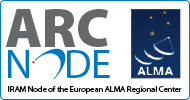News
First detection of glycolaldehyde outside the Galactic Center
Scientists from the Universitat de Barcelona-CSICM in Barcelona, the INAF-Istituto di Radioastronomia, the INAF-Osservatorio Astrofisico di Arcetri in Florence, the University College London in London, and the Institut de Radioastronomie Millimétrique (IRAM ) in Grenoble have detected for the first time outside the Galactic center the simplest of the monosaccharide sugars: glycolaldehyde. The importance of this organic molecule remains in the fact that it can react with propenal to form ribose, a central constituent of RNA, and is, therefore, directly linked to the origin of life. The organic molecule was found with the IRAM Interferometer in “G31.41+0.31”, a massive star forming region located at about 26000 light-years from Earth.
Interstellar glycolaldehyde was first detected near the Galactic center. However, the conditions in this region are quite extreme and do not represent average conditions in the Galaxy. Hence, it is difficult to understand whether the production of such a key ingredient for life is a common phenomenon throughout the Galaxy. The first detection of glycolaldehyde in an active star forming region is therefore most spectacular. “The importance of this discovery lies in the fact that the glycolaldehyde has been detected towards a region where planets orbiting newly formed stars are expected to exist - and planets could be the cradle of life”, points out Claudio Codella, astronomer of the INAF-Istituto di Radioastronomia in Florence, Italy.
The star forming region in question is called G31.41+0.31, a massive star-forming core located at a distance of about 26000 light-years. The core, which is 300000 times more luminous than the Sun and harbors deeply embedded newly formed hot stars, is one of the few massive star-forming objects where gas was found to rotate around. G31.41+0.31 is a well known hot core, characterized by high temperatures and densities, and a rich chemistry which can be studied thanks to the emission of molecular lines visible in the radio and microwave windows of the electromagnetic spectrum.
The region investigated by the international team of scientists was observed at high-angular resolution with the IRAM Interferometer at different wavelengths to search for different transitions of glycolaldehyde. The observations confirmed the presence of three lines of glycolaldehyde at 1, 2, and 3 mm towards the most central part of the core. The emission is clearly associated with the newly formed embedded stars, and is much less spread than the emission detected towards the Galactic center, or than that of other hot core tracers.
The detection of glycolaldehyde has profound implications for the chemistry of star-forming regions as it can help to constrain the evolutionary stage of the core, and therefore of the embedded young stars. What is more, this detection opens the road to the search of other life related complex molecular species that up to now have only been detected in the Galactic center.
“The discovery of glycolaldehyde in G31.41+0.31 is a groundbreaking result. The search for prebiotic molecules in star forming regions is still in the fledgling stages but the door is open now. I believe that many more of these molecules will show up in the near future”, says Roberto Neri, astronomer at IRAM and Project Scientist of the Plateau de Bure Interferometer.



